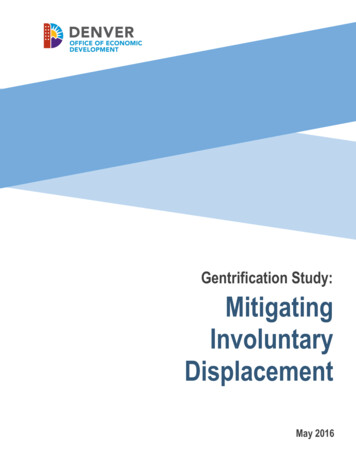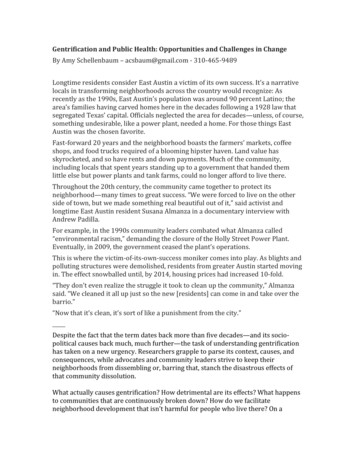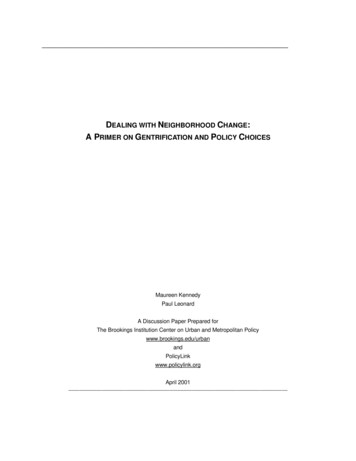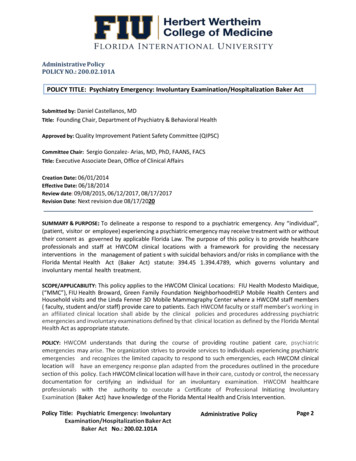
Transcription
Gentrification Study:MitigatingInvoluntaryDisplacementMay 2016
Table of ContentsA World-Class City Where Everyone Matters . 3Introduction . 4Summary of Findings and Recommendations . . . . 5Background . . 10Housing Denver and JumpStart 2016 . . 10Section 1Identifying Gentrification and Involuntary Displacement 11Key Reports . . 12Where is Gentrification Taking Place? .Figure 1. Governing Magazine Analysis: Denver Gentrification .Figure 2. Governing Magazine Map: Denver Gentrification .What Does Gentrification Mean for Residents? .12121313Section 2Gentrification in Denver . 15Section 3Mitigating Involuntary Displacement . . 18Appendix A.Appendix B.In the Face of Gentrification: Case Studies of Local Efforts 27Denver Gentrification Spatial Analysis Methodology 34The Portland Neighborhood Typology: Six Stages of Change .Denver Neighborhoods Analysis .Figure 3. Gentrification Typology .Figure 4. Vulnerable Neighborhoods in Denver 15151617Figure 5. Median Rent versus Affordable Rent in Denver, 2008-2014 . 19Promising Strategies from Other Cities . 20A. Affordable Housing Production and Financing . . 20B. Retention of Affordable Housing . 21C. Asset-Building of Existing Low and Moderate Income Residents . 23D. Other Strategies to Promote Affordable Housing and Revitalization 23E. Cross-Cutting Lessons From Case Studies . 24Denver’s Existing Tools to Build and Preserve Affordable Housing 26References . 40Gentrification Study: Mitigating Involuntary DisplacementMay 2016Page 2
A World-Class City Where Everyone MattersMayor Michael B. Hancock's vision for Denver is to deliver a world-class city where everyone matters. To achievethat goal, the City and County of Denver is working to ensure that all Denver’s residents, new and old, have theability to live where they can easily access economic opportunities and community support networks.The Office of Economic Development (OED) strives to create thoughtful strategies to enhance and reinvest inDenver’s neighborhoods without spurring involuntary displacement. Involuntary displacement means thatresidents and/or businesses are forced to relocate to neighborhoods where real estate is less costly. Thoseneighborhoods then become at-risk of experiencing concentrated poverty, which is linked to a host of negativesocial and economic outcomes for residents, especially children.The revitalization of disenfranchised neighborhoods is a result of both public and private investment and will be acritical test of how we, as a city, implement the Mayor’s vision. Policymakers now face the challenge ofdeliberately and proactively enabling the creation of mixed-income neighborhoods with opportunities for rentersand homeowners alike to stay in the city and participate in its well-established neighborhoods. Such a strategymeans not only mitigating involuntary displacement of existing residents, but also investing to ensure thatlong-time residents can access and benefit from opportunities created by economic growth.Gentrification Study: Mitigating Involuntary DisplacementMay 2016Page 3
IntroductionThis Gentrification Study: Mitigating Involuntary Displacement was proposed in JumpStart 2015, the strategic planof the Denver Office of Economic Development (OED), and it is an effort to research the magnitude of involuntarydisplacement in Denver and provide direction to OED’s investments and programs.The study examines where involuntary displacement appears to be taking place or appears to be at risk of takingplace in Denver, and suggests what the city can do to mitigate negative impacts of involuntary displacement whilecapturing the positive impacts of neighborhood reinvestment. Many Denver residents value diversity,inclusiveness and opportunity for all; however, these values are currently being threatened by the displacement oflong-time residents through involuntary displacement and a lack of economic opportunities.While a number of the actions proposed could be accomplished using existing resources, others will require newinvestments, reallocation of existing resources and strong community partnerships. The impacts of gentrificationand involuntary displacement touch many aspects of neighborhood life which are outside of OED’s sphere ofinfluence. One recommended action item is for the city to convene conversations with partner agencies andcommunity organizations to begin building a more comprehensive citywide strategy to address involuntarydisplacement.The term “gentrification” encompasses a complex group of neighborhood dynamics, some positive and somenegative. Involuntary displacement is a clearly negative impact of gentrification that the city can take action tomitigate. This report recognizes that some phenomena associated with gentrification can create opportunity forneighborhood residents if paired with strategic public investments. For this study, we have chosen to use thedefinition of “gentrification” presented by Lisa Bates of Portland State University in her Gentrification andDisplacement study for the City of Portland (Bates, 2013). Bates offers an operational definition with measurablecharacteristics in three areas at the neighborhood scale: housing market changes, economic status changes anddemographic changes:“Gentrification [is the process that] occurs when a neighborhood has attractive qualities—for example, location or historic architecture—but remains relatively low value. Thedisconnect between potential value and current value (called “the rent gap”) may occurdue to historic disinvestment by public and private sectors. When the area becomesdesirable to higher-income households and/or investors, there are changes in thehousing market. As demand rises for the neighborhood, higher-income householdsare able to outbid low-income residents for housing, and new development and economicactivity begins to cater to higher-income tastes. Lower-income households and/orhouseholds of color migrate out of the neighborhood and new in-migrants changethe demographics of the neighborhood.”The findings and recommendations that follow summarize what the city can to do minimize involuntarydisplacement while supporting existing residents in accessing new economic opportunities. It is OED’s intentionto research this issue in Denver and to provide direction to future investments and activities that OED and othercity departments undertake.The goals of this report are to:Identify factors that cause residential and commercial displacement;Identify neighborhoods where displacement is currently happening or could happen;Research promising practices in other cities that are working to minimize displacement asneighborhoods are being revitalized; andInform the discussion and decisions for OED investments in light of the office’s goal of equitableneighborhood revitalization.Gentrification Study: Mitigating Involuntary DisplacementMay 2016Page 4
Summary Findings and RecommendationsThis section would normally appear at the end of a report, but has intentionally been moved forward to highlightthis material for policy briefing purposes.OED develops its annual strategic plan of work, JumpStart, across major headings of business development, smallbusiness advocacy, housing, neighborhood development, and workforce development. JumpStart 2016 isavailable online at dies.html. This gentrification study relates directly to JumpStart 2016, as noted throughout thissection.In 2014, OED released Housing Denver, an ambitious five-year strategy to prioritize Denver’s affordable housingchallenges and recommend executable strategies to address such challenges. Many of the strategies and actionitems identified in the Housing Denver plan are already being executed by OED and will be critical to mitigatinginvoluntary displacement in neighborhoods that are at risk.Finding A. There is no silver bullet.Recommendation 1.Recommendation 2.Collaborate across agencies on strategies to mitigate displacement.Address potential for involuntary displacement in neighborhood plans.Finding B. Investment in affordable housing continues to be a critical need.Recommendation 3.Recommendation 4.Recommendation 5.Recommendation 6.Recommendation 7.Create a robust permanent funding source for affordable housing.Preserve existing affordable housing.Bank land in neighborhoods at risk of involuntary displacement.Protect existing homeowners.Use the study’s neighborhood typology to evaluate investments.Finding C. Access to economic opportunity needs to be considered as part of public investments.Recommendation 8.Recommendation 9.Recommendation 10.Recommendation 11.Recommendation 12.Provide technical support to neighborhood businesses to managechanges in customer base.Tie business incentives to community engagement that benefits low-income residents.Make training for middle-income jobs available to neighborhood residents.Support entrepreneurship in gentrifying neighborhoods.Preserve industrial space and middle-skill jobs.Finding A. There is no silver bullet.Gentrification is most often the result of market forces and there is no silver bullet. In other words, there is nosingle tactic or quick fix for a city to benefit from neighborhood revitalization while avoiding involuntarydisplacement. Cities must be proactive and implement multiple strategies over a long time to mitigate involuntarydisplacement. OED has a broad set of tools, ranging from affordable housing development to small businesssupport to employment and training, that can help mitigate the negative impacts of gentrification and increaseeconomic and community opportunity; however, a successful strategy to address involuntary displacement mustinclude other city agencies as well as community partners.Gentrification Study: Mitigating Involuntary DisplacementMay 2016Page 5
Recommendation 1.Collaborate across agencies on strategies to mitigate displacement. Convene a collective impact workinggroup to coordinate a comprehensive set of strategies that brings OED together with other city agencies such asCommunity Planning and Development (CPD), Parks and Recreation, Public Works, Office of Children’s Affairs,and the Mayor’s Office; with partners such as the Denver Housing Authority, Denver Urban Renewal Authority,Mile High United Way, and neighborhood development collaboratives; and with the Denver Public Schools, theCommunity College of Denver and other educational institutions.See JumpStart 2016: Housing – Partnerships, Agency Alignment, and Gentrification.Recommendation 2.Address the potential for involuntary displacement in neighborhood plans. Collaborate with CPD to ensurethat neighborhood plans consider the potential for displacement in each neighborhood and include strategies tominimize involuntary displacement. Strengthen CPD and OED coordination on future neighborhood planningefforts to address the need for housing and business opportunity, and to include strategies to mitigate thenegative effects of gentrification.Finding B. Investment in affordable housing continues to be a critical need.The rate of increase in Denver’s median household income has significantly outpaced Colorado’s and thenational rate. Nonetheless, even with these healthy increases, Denver’s household earnings are notkeeping up with housing prices and rent increases. The disparity in household income and housing costs makespublic investment critical to increase the supply of affordable workforce housing, and therefore decrease costs,to help low- and moderate-income families and individuals afford to remain in the city.Recommendation 3.Create a robust permanent funding source for affordable housing. The top priority in Housing Denver wasto find a permanent fund to develop affordable housing. The top housing recommendation in this report is thesame. Leveraging funds from the Colorado Housing Finance Authority, in 2015 the city invested 6 million in anew Revolving Affordable Housing Loan Fund. Mayor Hancock has set aside another 8 million from the 2016budget for affordable housing, and has announced plans to dedicate 15 million of city funds annually over tenyears to affordable housing investment, beginning in 2017. Appendix A contains information on what other citieshave done to create similar funds.Recommendation 4.Preserve existing affordable housing. Another key recommendation of the Housing Denver report was toinvest in the preservation of existing affordable housing, particularly rentals. In 2015 the city strengthened itsaffordable housing preservation ordinance to give the city increased notice of expiring covenants and a right offirst refusal on covenant-restricted properties for sale. OED has also been an active participant in a statewidepreservation collaborative and is developing a mapping system that will identify and target Denver propertieswith expiring covenants.See JumpStart 2016: Housing – Westwood, Preservation, Project-Based Vouchers, Fair Housing, andInclusionary Housing Ordinance.Gentrification Study: Mitigating Involuntary DisplacementMay 2016Page 6
Recommendation 5.Bank land in neighborhoods at risk of involuntary displacement. A proactive strategy is land banking—acquiring land for affordable housing in areas where land values are projected to increase sharply over the nextseveral years. OED should consider strategies that recognize the impact of public investments on affordabilityand land values. Whenever possible, OED should consider supporting its partner entities to bank land at thebeginning of a project to develop affordable housing and create mixed-income neighborhoods. The city is a keyinvestor in the Mile High Transit-Oriented Development Fund, which provides financing for the acquisition anddevelopment of vacant property in proximity to light rail stations and high frequency bus corridors for usesthat include affordable housing. In 2015 OED partnered with the Urban Land Conservancy to acquire six acresof property within walking distance of the National Western Center light rail station at 48th & Race.See JumpStart 2016: Housing - Land Banking.Recommendation 6.Protect existing homeowners. Promote and maximize enrollment in the current state program to deferproperty taxes to protect long-time homeowners, with special attention to ensure that seniors and others onfixed incomes have the ability to stay in their homes.See JumpStart 2016: Housing – Home Ownership, Neighborhood Development – Globeville/Elyria-Swansea.Recommendation 7.Use the study’s neighborhood typology to evaluate investments. The neighborhood typology used in thisreport provides new insight into where affordable housing investments could have a significant impact onmitigating involuntary displacement. Going forward, the housing mapping tool used to generate the mapspresented in this report, as well as maps of existing income-restricted units and vacant land opportunities, willprovide key data and analysis to support affordable housing investment decisions. In collaboration with otheragencies, this typology will be useful to assess the potential neighborhood impact of a wide range of cityinitiatives.See JumpStart 2016: Neighborhood Development - Collective Impact, Five Points.Finding C. Access to economic opportunity needs to be considered part of publicinvestments.Denver’s economy and population are booming. Investing aggressively in affordable housing is critical, buthousing-based strategies must also be paired with strategies to build existing residents’ economiccapacity. With the right strategies and supports, neighborhood reinvestment offers the potential to create neweconomic opportunity for existing residents. Keeping investment out of some neighborhoods to avoidgentrification while the rest of the city prospers is not a positive strategy for the long-term success ofneighborhood residents.Gentrification Study: Mitigating Involuntary DisplacementMay 2016Page 7
Recommendation 8.Provide technical support to neighborhood businesses to manage changes in customer base. Focustechnical and financial assistance efforts on existing businesses in gentrifying neighborhoods andneighborhoods at risk of involuntary displacement. Ensure that commercial displacement is minimal and assistbusinesses to continue to cater to the existing neighbors and expand the types of goods and services thatappeal to the new residents in the neighborhood. OED uses a revolving business loan fund thatprovides loans to small businesses in low-income neighborhoods. In addition, OED’s Business DevelopmentRepresentatives could be deployed to assist businesses in gentrifying neighborhoods and to market OED’srevolving loan funds to neighborhood businesses to help mitigate commercial displacement.See JumpStart 2016: Small Business Advocacy – Supply Chain Matching, Technical Support and Assistance,Five Points, Montbello, East Colfax, Small Business Loan Fund Pilot, Revitalizing Neighborhood Retail Centers.Recommendation 9.Tie business incentives to community engagement that benefits low-income residents. When OED ismaking significant investments through business incentives, consider asking businesses to develop a mutuallyagreed upon neighborhood engagement strategy that addresses some of the specific needs of theneighborhood, including commitments to hire neighborhood residents, patronize local restaurants andengage local small businesses into the supply chain of businesses receiving business incentives.See JumpStart 2016: Business Development – Attract Foreign Direct Investment, Opportunity Leads, GrowthIndustries.Recommendation 10.Make training for middle-income jobs available to neighborhood residents. In neighborhoods that areat risk of involuntary displacement, target workforce investments to provide training and educationopportunities that will help low-income residents achieve economic mobility. In cases where targetedneighborhoods are experiencing significant business investment or job growth, tailor training opportunities tohelp residents access middle-skill jobs being created in the neighborhood. OED can offer Individual TrainingAccounts (ITAs) for jobseekers who need skills training to obtain jobs, and plans to serve 200 jobseekers in the2016-17 funding year with ITAs typically capped at 3,000. The city must continue to reach out to nonprofits andindividuals in areas at risk of involuntary displacement and make all residents aware of the availability of ITAsand other training opportunities. In addition, OED has a federal grant to train unemployed workers for H1-Boccupations such as information technology and advanced manufacturing.See JumpStart 2016: Business Development — JumpStart Academy, Section 3, Resource Directory; WorkforceDevelopment — Career Paths, Customized Recruitment Service, Industry-Focused Training Programs.Recommendation 11.Support entrepreneurs in gentrifying neighborhoods. OED could specifically target resources to supportexisting resident-owned businesses in neighborhoods that are at risk of involuntary displacement. OED couldalso partner with high-growth companies that are expanding in Denver to explore opportunities to supportexisting and aspiring entrepreneurs who are women, people of color, and/or low-income residents in theseareas.See JumpStart 2016: Small Business Advocacy – Collaborative Workspace; Neighborhood Development —Community Wealth-Building, Fresh Food; Business Development — JumpStart Academy, Section 3, ResourceDirectory.Gentrification Study: Mitigating Involuntary DisplacementMay 2016Page 8
Recommendation 12.Preserve industrial space and middle-skill jobs. OED should work to preserve and potentially increase theavailability of industrial and commercial space in neighborhoods that are at risk for involuntary displacement.These efforts should focus on preserving space for businesses or industries that provide middle-skill jobs payinga family-supporting wage. Where middle-skill jobs are preserved, an ongoing training pipeline is also needed tohelp residents access these opportunities.See JumpStart 2016: Business Development - Manufacturing and Innovation Hub, Manufacturing TrainingProgramsGentrification Study: Mitigating Involuntary DisplacementMay 2016Page 9
BackgroundThrough smart investments and visionary leadership, Denver has emerged out of the 2008 recession to become acenter of ideas and talent, which is attracting firms and investment from the West Coast and elsewhere. This,along with a competitive cost of living, has made Denver a leading economic force in the United States for the lastthree to four years.Denver’s economic climate today is one of brisk growth, investment and rapidly accelerating home values. Thevalues and amenities that for decades have made Denver a great place to grow up and raise a family are alsomaking Denver a preferred destination.According to the latest Census data, more than 1,000 new households move to Denver every month. Denver hasseen an influx of young and highly educated residents, which has led to the displacement of long-time residents insome of the oldest neighborhoods and has fueled concerns that many of Denver’s neighborhoods are rapidlybecoming unaffordable to many people.This growth is challenging policymakers to consider investments and choices to maintain our quality of life and toprovide opportunities for all. Denver voters have recently made significant investments in our educational system,neighborhoods, and infrastructure—investments which are testaments to the commitment to remain an inclusivecommunity where prosperity is shared by all residents. Bold leadership and meaningful investments must continuein order to achieve this goal.Housing Denver and JumpStart 2016Mayor Michael B. Hancock and the Office of Economic Development unveiled Housing Denver, a five-yearhousing plan, in October 2014. The plan is the result of extensive input from stakeholders, including housingadvocates, foundations, housing finance experts and neighborhood residents. Housing Denver aims to harnessthe resources of the public and private sectors to increase affordable housing for individuals and families.This study follows the OED’s release of JumpStart 2016, its annual plan, which includes a three-year window ofstrategic action for 2016-2018. Many of OED’s guiding principles and strategic priorities coordinate directly to theissues of involuntary displacement, including supporting small businesses, economic mobility, housing, andemployment in vulnerable neighborhoods.This study was conducted to inform the City and County of Denver’s programs and investments with a focus onguiding OED’s approaches, practices, and activities such that potential negative impacts of neighborhoodredevelopment are mitigated and existing residents benefit from public investments.Many of this study’s recommendations echo key priorities from the Housing Denver plan, including creating apermanent funding source for affordable housing. The report will illustrate how the actions that are beingundertaken as part of the Housing Denver plan can be layered with other tools and strategies within OED to createa comprehensive strategy to fight involuntary displacement. Behind such a strategy is the acknowledgment that,while affordable housing is a critical policy intervention that can directly mitigate involuntary displacement,affordable housing investments are not enough to combat the negative impacts of gentrification on their own.We recognize that issues such as changing social, cultural, and general neighborhood character are importantaspects of gentrification. These issues will be addressed by OED to the extent possible given the purview ofOED’s programs and activities, and by collaborating with other city agencies and community organizations toensure that equitable revitalization is a collective priority.Gentrification Study: Mitigating Involuntary DisplacementMay 2016Page 10
Section 1. Identifying Gentrification and Involuntary Displacement“Gentrification” is a process that seems easy to identify, but can be challenging to define. There is significantdebate among scholars on what specific social and economic processes make up what we typically identify asgentrification – and to what extent each of those processes has a positive or negative impact on residents,neighborhoods, and the city as a whole.Gentrification. As noted previously, this study uses the definition proposed by Lisa Bates of Portland StateUniversity in her Gentrification and Displacement study for the City of Portland.Involuntary Displacement. An important element of the Bates study is that it makes the negativeconsequences of involuntary housing displacement its defining focus. She frames involuntary displacementas the distinction between revitalization and gentrification:“Revitalization is usually desired by current residents and can have many positiveoutcomes for cities, neighborhoods, and individuals. Here, we focus on the negativeconsequences of involuntary residential displacement as the distinction betweenrevitalization and gentrification. Rather than debating the complex causality ofneighborhood change or attempting to weigh all its positive benefits and costs, thisapproach places an emphasis on recognizing and avoiding the displacement ofresidents as their neighborhood receives new investments and upgrades.”Equitable Development. Writing for the Brookings Institution, Maureen Kennedy and Paul Leonard argue that“equitable development” should be the goal of revitalization (Kennedy and Leonard, 2001). This study uses theirdefinition of equitable development to describe a positive process of revitalization without involuntarydisplacement:“We define equitable development as the creation and maintenance of economicallyand socially diverse communities that are stable over the long term through meansthat generate a minimum of transition costs that fall unfairly on lower income residents.”This report mirrors the Portland gentrification study’s focus on involuntary displacement as the key negativeimpact of gentrification. The strategies and recommendations presented in this report also reflect Kennedy andLeonard’s definition of equitable development. Their definition suggests that, to ensure that investment drivesequitable development rather than involuntary displacement, policymakers must not only help mitigate negativeimpacts but also take positive steps to ensure that investments support broadly shared prosperity.Affordable Housing. OED uses the customary definition of affordable housing as being the combination of amonthly mortgage payment (or rent) and utilities, which together do not consume more than 30% of ahousehold’s gross monthly income. Households spending over the 30% level are considered cost-burdened.Gentrification Study: Mitigating Involuntary DisplacementMay 2016Page 11
Key ReportsThere are hundreds—if not thousands—of reports on gentrification: the positive aspects, the negative aspects,what cities have done or plan to do, as well as studies that argue that the persistence of poverty, theconcentration of poverty in neighborhoods and the growth of poverty in cities and suburbs are the most importantthreats to cities—not gentrification.The Federal Reserve Bank of San Francisco recently released “Gentrification, Displacement and the Role ofPublic Investment: A Literature Review” (Zuk et al, 2015). This report, led by Berkeley and UCLA urban planningfaculty, delves into the social science of gentrification in great detail, examining some of the fundamentalassumptions about neighborhoods and housing choice that underlie our general understanding of gentrification.Rather than replicating the analysis of that study, this report focuses on a handful of key studies that can informOED’s approach to understanding and mitigating involuntary displacement.Where is Gentrification Taking Place?In order to implement an effective strategy to mitigate gentrification, first we must be able to understand wheregentrification is taking place. The most commonly used methodology for measuring gentrification was designed byLance Freeman of Columbia University using Census tract-level data to examine changes in population andhousing characteristics over time (Freeman, 2005).In February 2015, Governing magazine published a report on gentrification that pares down the variablesmeasuring gentrification to just two: increase in home value and increase in the population with a collegedegree. The results determine whether a tract that was “eligible to gentrify” did or did not gentrify over a certaintime period; a tract was considered eligible to gentrify if it had lower than average household income and lowerthan average home values (Maciag, 2015).Figure 1 shows the results of the Governing magazine analysis applied to Census tracts in Denver. Of tracts“eligible to gentrify,” 42% have gentrified since 2000, meaning that they were in the top third of all Denver tractsanalyzed in terms of how much home values and residents with college degrees have increased. This result putsDenver at #7 of the 50 largest U.S. cities in terms of the extent of gentrification.Figure 1: Governing Magazine Analysis: Denver Gentrification% of Eligible TractsGentrifyingTractsGentrifyingDid NotGentrifyNot Eligible toGentrifyTotalCensus TractsSince 200042.1%2433871441990-200031.8%214578144Source:
Introduction This Gentrification Study: Mitigating Involuntary Displacement was proposed in JumpStart 2015, the strategic plan of the Denver Office of Economic Development (OED), and it is an effort to research the magnitude of involuntary displacement in Denver and provide direction to OED's investments and programs.










